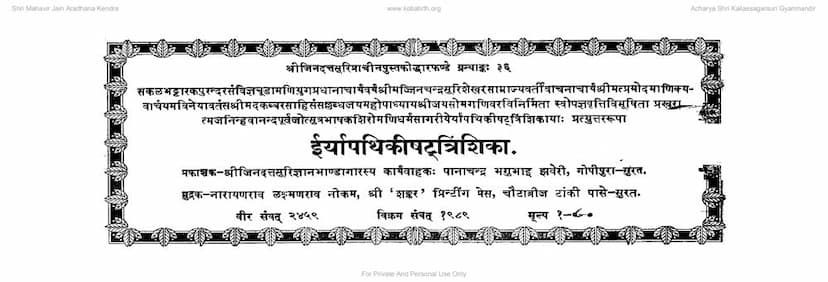Iryapathiki Shatrinshika
Added to library: September 1, 2025

Summary
Here's a comprehensive summary of the Jain text "Iryapathiki Shatrinshika" by Jaysomgani, based on the provided pages:
Book Title: Iryapathiki Shatrinshika (ईर्यापथीकी षट्त्रिंशिका) Author: Jaysomgani (जयसोमगणिवर) Publisher: Jinduttsuri Gyanbhandar (श्रीजिनदत्तसूरिज्ञानभाण्डागार) Catalog Link: https://jainqq.org/explore/020384/1
Core Subject:
The "Iryapathiki Shatrinshika" is a commentary and treatise by Jaysomgani that addresses a significant point of contention within Jain practice: the timing and sequence of the Iryapatha (ईर्यापथा) or Iryapathiki (ईर्यापथीकी) transgression confession in relation to the Samayika (सामायिक) vow.
Context and Historical Background:
The text highlights a historical debate and differing interpretations regarding the order of rituals. It mentions that in earlier times, there was a clear understanding of the sequence of practices. However, over time, due to a perceived decline in adherence to strict practices (shithilachar), disputes arose.
The author references various ancient Jain texts and commentaries, including:
- Aavashyak Sutra (आवश्यकसूत्र)
- Mahanishith Sutra (महानिशीथसूत्र)
- Abhaydev Suri's commentaries
- Haribhadra Suri's works
- Udyotan Suri and Vardhaman Suri's critiques of sectarian practices.
The text points to a faction, including the scholar Dharmasagar, who advocated for a different order of practice, potentially seeing the confession of Iryapatha transgressions before the Samayika vow or in a different context than traditionally understood. Jaysomgani's work is presented as a counter-response (pratyuttar or uttar roopa) to these differing views, specifically to those who allegedly twisted or misinterpreted scriptural injunctions out of animosity.
Key Arguments and Interpretations Presented by Jaysomgani:
-
The Correct Sequence: The primary argument is that the Iryapatha confession (प्रतिक्रमण) must follow the Samayika vow (सामायिकदण्डक पाठ). This is based on scriptural injunctions and the interpretation of various authoritative commentaries like those of Abhaydev Suri, Yashodev Upadhyay, and Devgupta Suri. These commentaries consistently place the Iryapatha confession after the recitation of the Samayika vow.
-
Purpose of Samayika and Iryapatha:
- Samayika is defined as the renunciation of sinful activities (savajja yoga) and the engagement in sinless activities (anavajja yoga).
- Iryapatha refers to transgressions committed while moving or during the path of journey. The confession is a process of seeking forgiveness for these transgressions.
-
The Role of Chaitya Vandan (चैत्य वंदन): The text discusses the placement of Chaitya Vandan (worship of Jina idols/temples) in relation to Samayika and Iryapatha. While some interpretations might place it between the Samayika recitation and the Iryapatha confession, Jaysomgani, in defending the traditional sequence, argues that the core principle is the sequence of Samayika followed by Iryapatha confession. He addresses instances where Chaitya Vandan might occur differently based on circumstances, but maintains the fundamental order of the other two.
-
Interpretation of Mahanishith Sutra: A significant portion of the text is dedicated to refuting the opposing viewpoint's interpretation of the Mahanishith Sutra. The opposing side allegedly used a general statement from Mahanishith Sutra ("Apraatikraantaya iryaavahita na kapati kinvachi...") to argue that no religious activity can be performed without first confessing Iryapatha transgressions. Jaysomgani argues that this Mahanishith Sutra verse is specific (vishesh) and applies to particular contexts or rituals, not as a general rule for all religious activities like Samayika or Chaitya Vandan. He contrasts this with general (saamanya) principles found elsewhere. He stresses that when specific injunctions conflict with general ones, the specific ones prevail.
-
Refutation of Alternative Interpretations: Jaysomgani systematically dismantles the arguments of those who advocate for a different timing or meaning of Iryapatha. He addresses:
- Grammatical Arguments: He analyzes the use of the fifth case (panchami vibhakti) in phrases like "Pashchaad Iryapathikayaa pratkramati" (पश्चादीर्यापथिकयाः प्रतिक्रामति) and argues that it does not necessarily imply the meaning of "leaving behind" or "abstaining from movement." He provides alternative scriptural examples where the fifth case is used differently.
- Misinterpretation of "Pashchaat" (पश्चात्): He refutes the idea that "pashchaat" (after) in some texts implies "later in time" or "after movement." He argues it can mean "subsequent" in a ritualistic order, not necessarily signifying a temporal gap after movement.
- Role of Sva-mata (Self-Opinion): He criticizes those who create new interpretations (navaartha) based on their own opinions (sva-mata) rather than adhering to the established traditions and the teachings of their gurus and ancient scholars. He labels such interpretations as rootless (nimoolo) and driven by prejudice (abhinivesh).
-
The Importance of Tradition and Guruparampara: The author strongly emphasizes the authority of the lineage of Jain gurus (guruparampara) and the established interpretations of ancient scholars. He states that his own work is based on this tradition and that deviating from it is a serious offense against the Jinasasana.
-
The Author's Credentials: The text explicitly states that Jaysomgani was a disciple (vineya) of Shri Pramod Manikyavachanam, who was himself a disciple of Shri Jinachandra Suri. He mentions receiving instructions and guidance from his gurus. The work is dedicated to establishing the traditional understanding and refuting misinterpretations that arose, possibly due to later schisms or differences in practice.
-
Critique of Dharmasagar and others: The text directly criticizes the views of Dharmasagar and others who are accused of misinterpreting scriptures out of malice or prejudice. Jaysomgani calls their interpretations "utsootra" (unsutras - against the scriptural rules) and their reasoning flawed.
-
Examples from Ancient Texts: Jaysomgani diligently cites and analyzes passages from various Jain texts to support his arguments, demonstrating the historical precedent for the sequence he advocates. He uses these citations to highlight the consistency of the traditional view across different authoritative sources.
-
Conclusion: The "Iryapathiki Shatrinshika" aims to clarify the correct ritualistic order within Jainism, specifically asserting that the confession of Iryapatha transgressions is a practice that follows the Samayika vow. It serves as a defense of established Jain tradition against what the author perceives as erroneous interpretations that arose later in history. The author's commentary aims to guide practitioners back to the pure, traditional understanding based on the teachings of ancient scholars and gurus.